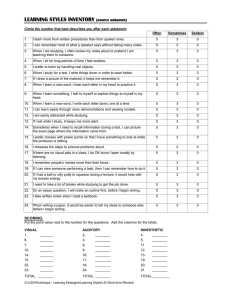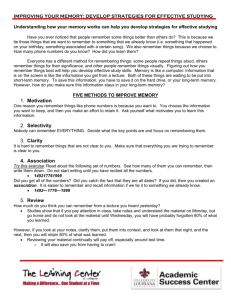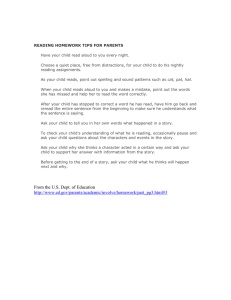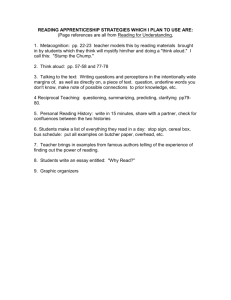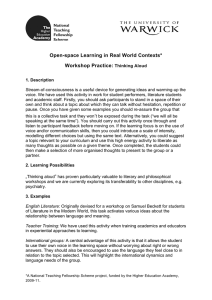Suggestions for Visual, Auditory & Kinesthetic Learners Visual Learner Suggestions
advertisement
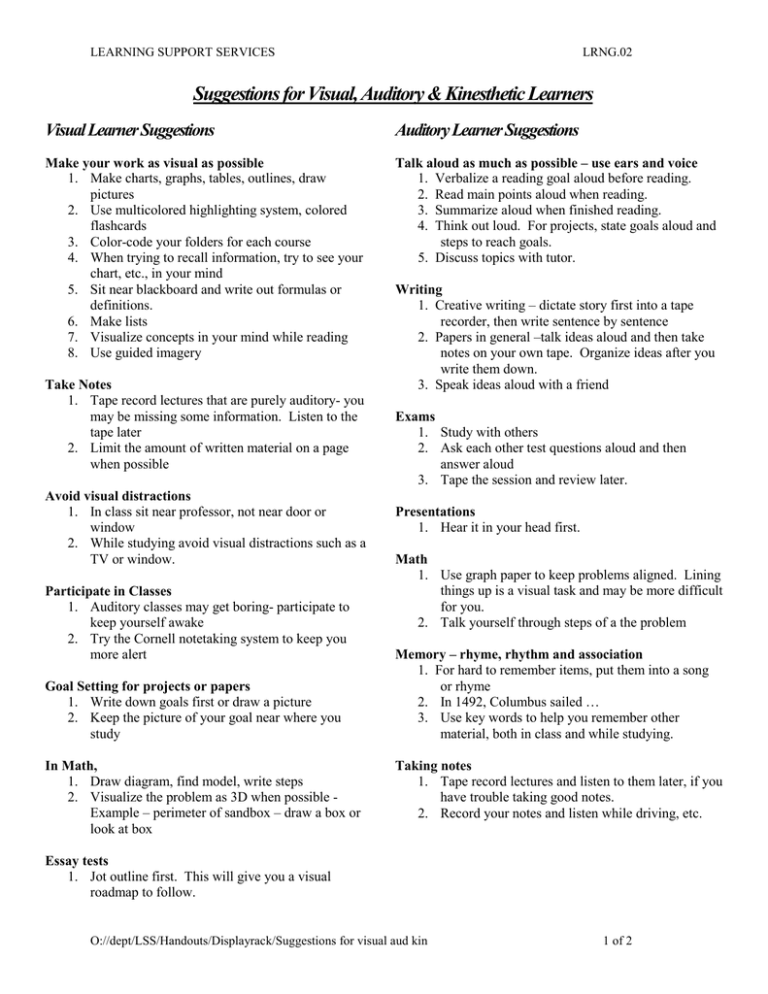
LEARNING SUPPORT SERVICES LRNG.02 Suggestions for Visual, Auditory & Kinesthetic Learners Visual Learner Suggestions Auditory Learner Suggestions Make your work as visual as possible 1. Make charts, graphs, tables, outlines, draw pictures 2. Use multicolored highlighting system, colored flashcards 3. Color-code your folders for each course 4. When trying to recall information, try to see your chart, etc., in your mind 5. Sit near blackboard and write out formulas or definitions. 6. Make lists 7. Visualize concepts in your mind while reading 8. Use guided imagery Talk aloud as much as possible – use ears and voice 1. Verbalize a reading goal aloud before reading. 2. Read main points aloud when reading. 3. Summarize aloud when finished reading. 4. Think out loud. For projects, state goals aloud and steps to reach goals. 5. Discuss topics with tutor. Take Notes 1. Tape record lectures that are purely auditory- you may be missing some information. Listen to the tape later 2. Limit the amount of written material on a page when possible Avoid visual distractions 1. In class sit near professor, not near door or window 2. While studying avoid visual distractions such as a TV or window. Participate in Classes 1. Auditory classes may get boring- participate to keep yourself awake 2. Try the Cornell notetaking system to keep you more alert Goal Setting for projects or papers 1. Write down goals first or draw a picture 2. Keep the picture of your goal near where you study In Math, 1. Draw diagram, find model, write steps 2. Visualize the problem as 3D when possible Example – perimeter of sandbox – draw a box or look at box Writing 1. Creative writing – dictate story first into a tape recorder, then write sentence by sentence 2. Papers in general –talk ideas aloud and then take notes on your own tape. Organize ideas after you write them down. 3. Speak ideas aloud with a friend Exams 1. Study with others 2. Ask each other test questions aloud and then answer aloud 3. Tape the session and review later. Presentations 1. Hear it in your head first. Math 1. Use graph paper to keep problems aligned. Lining things up is a visual task and may be more difficult for you. 2. Talk yourself through steps of a the problem Memory – rhyme, rhythm and association 1. For hard to remember items, put them into a song or rhyme 2. In 1492, Columbus sailed … 3. Use key words to help you remember other material, both in class and while studying. Taking notes 1. Tape record lectures and listen to them later, if you have trouble taking good notes. 2. Record your notes and listen while driving, etc. Essay tests 1. Jot outline first. This will give you a visual roadmap to follow. O://dept/LSS/Handouts/Displayrack/Suggestions for visual aud kin 1 of 2 LEARNING SUPPORT SERVICES LRNG.02 Kinesthetic Learner Suggestions Make studying more physical 1. Stand while reading 2. Pace or exercise while reading 3. Take frequent breaks 4. Set a white board to write on while studying 5. Chew gum while studying Vary your activities 1. Alternate between subjects 2. If you can’t do that, alternate methods used. For example, switch from making flashcards, to reading, to making an outline Avoid distractions 1. Sit in front – not by doors or windows, or friends 2. Cover part of page you are not reading 3. Keep a distractions list next to you while reading 4. Keep a watch that goes off every 15 minutes- ask yourself, “am I on task?” 5. Play music while reading or white noise machine. 6. Study with a clean desk. 7. Where ear plugs 8. Study in a study carrel Time management 1. Keep calendar – assignments, due dates 2. Make a daily schedule for each day. 3. Break down projects into small pieces 4. Use ABC time management system 5. Have a “check in” person who you tell your goals and tasks to 6. Keep all of your materials together in a backpack, etc. so you always know you have what your need. Use active approaches while studying 1. Short breaks every 30-45 minutes 2. Study partner could help 3. Avoid cramming – too much sitting time 4. Use the SQ4R technique 5. Use mapping technique 6. Think of real world examples for what you are reading. Make models. Act out reactions. Act out events in history. 7. Choose applied, hands-on classes when possible 8. Take difficult subjects in the morning. Avoid sitting in lecture all day and break up classes with periods of activity. 9. Role play Source Unknown 7/2008 O://dept/LSS/Handouts/Displayrack/Suggestions for visual aud kin 2 of 2
